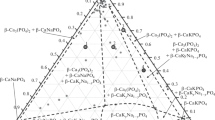A composite bioceramic with density at least 80% of the theoretical value was obtained from thermolyzed octacalcium phosphate (OCP). The treatment temperatures of OCP were 450, 600, and 700°C. The ceramic was obtained by firing thermolyzed powders at maximum temperature 1000, 1050, and 1100°C with soaking for 3, 6, and 9 h. Samples obtained from OCP treated at 450°C demonstrate the highest strength in bending (up to 125 MPa).






Similar content being viewed by others
References
P. D. Sarkisov and N. Yu. Mikhailenko, “Bioactive inorganic materials for bone endoprostheses,” Tekh. Tekhnol. Silikatov, 1(2), 5 – 11 (1994).
V. I. Putlyaev and T. V. Safronova, “Next-generation calcium phosphate biomaterials: the role of phase and chemical compositions,” Steklo Keram., No. 3, 30 – 33 (2006); V. I. Putlyaev and T. V. Safronova, “A new generation of calcium phosphate biomaterials: the role of phase and chemical compositions,” Glass Ceram., 63(3 – 4), 99 – 102 (2006).
A. G. Veresov, V. I. Putlyaev, and Yu. D. Tret’yakov, “Advances in the field of calcium phosphate biomaterials,” Ross. Khim. Zh., 44(6), Pt. 2, 32 – 46 (2000).
S. M. Barinov and V. S. Komlev, Bioceramic Based on Calcium Phosphate [in Russian], Nauka, Moscow (2005).
W. Suchanek and M. Yoshimura, “Processing and properties of hydroxyapatite-based biomaterials for use as hard tissue replacement implants,” J. Mater. Res., 13(1), 94 – 117 (1998).
M. A. Gol’dberg, V. V. Smirnov, S. V. Kutsev, et al., “Composite ceramic materials in the system hydroxyapatite – calcium carbonate,” Neorg. Mater., 46(11), 1397 – 1402 (2010).
M. Otsuka, S. Marunaka, Y. Matsuda, et al., “Calcium level responsive in-vitro zinc release from zinc containing tricalcium phosphate (ZnTCP),” J. Biomed. Mater. Res., 52, 819 – 824 (2000).
J. Barralet, S. Best, and W. Bonfield, “Carbonate substitution in precipitated hydroxyapatite: An investigation into the effects of reaction temperature and bicarbonate ion concentration,” J. Biomed. Mater. Res., 41, 79 – 86 (1998).
T. V. Safronova, A. V. Knot’ko, T. V. Shatalova, et al., “Calcium phosphate ceramic based on powder synthesized from a mixedanionic solution,” Steklo Keram., No. 1, 27 – 34 (2016); T. V. Safronova, A. V. Knot’ko, T. V. Shatalova, et al., “Calcium phosphate ceramic based on powder synthesized from a mixedanionic solution,” Glass Ceram., 73(1 – 2), 25 – 31 (2016).
T. V. Safronova, V. I. Putlyaev,M. A. Shekhirev, and A. V. Kuznetsov, “Composite ceramic containing a bioresorbable phase,” Steklo Keram., No. 3, 31 – 35 (2007); T. V. Safronova, V. I. Putlyaev, M. A. Shekhirev, and A. V. Kuznetsov, “Composite ceramic containing a bioresorbable phase,” Glass Ceram., 64(3 – 4), 102 – 106 (2007).
T. Kanazawa, Inorganic Phosphate Materials [Russian translation], Naukova Dumka, Kiev (1998).
K. Sakamoto, S. Yamaguchi, M. Kaneno, et al., “Synthesis and thermal decomposition of layered calcium phosphates including carboxylate ions,” Thin Solid Films, 517(4), 1354 – 1357 (2008).
V. I. Putlyaev, T. V. Safronova, E. V. Kukueva, and Yu. D. Tret’-yakov, “Method of obtaining ceramic biodegradable material, RF Patent 245653, IPC A61L27/12, IPC B82B3/00, IPC C04B35/447,” Byull. Izobr. Polezn. Modeli (2012), published July 20, 2012.
V. I. Putlyaev, E. V. Kukueva, T. V. Safronova, et al., “Features of octacalcium phosphate thermolysis,” Refract. Industr. Ceram., 54(5), 420 – 424 (2014).
S. Deville, E. Saiz, R. K. Nalla, and A. P. Tomsia,”Freezing as a path to build complex composites,” Science, 3(11), 515 – 518 (2006).
This work was performed using equipment provided by the Program of Development of Moscow University. The research conducted was supported by RFFI Grants Nos. 15-03-09387, 16-08-01172, and 16-53-00154.
Author information
Authors and Affiliations
Corresponding author
Additional information
Translated from Steklo i Keramika, No. 2, pp. 37 – 42, February, 2017.
Rights and permissions
About this article
Cite this article
Kukueva, E.V., Putlyaev, V.I., Safronova, T.V. et al. Composite Bioceramic Based on Octacalcium Phosphate Decomposition Products. Glass Ceram 74, 67–72 (2017). https://doi.org/10.1007/s10717-017-9931-2
Published:
Issue Date:
DOI: https://doi.org/10.1007/s10717-017-9931-2




